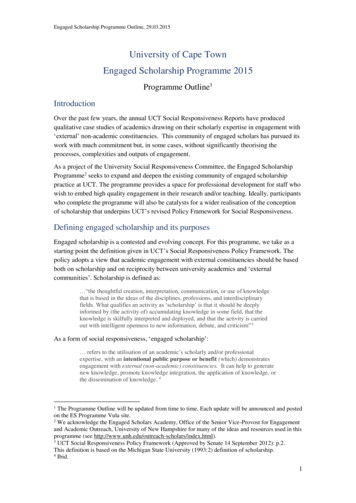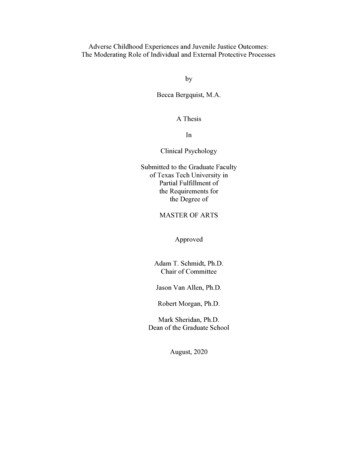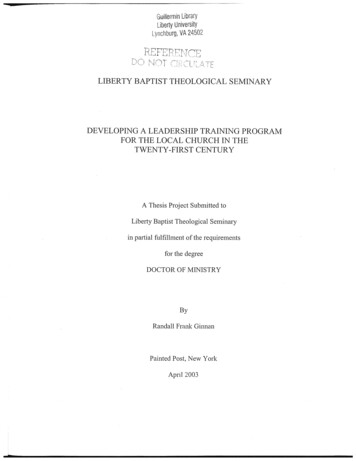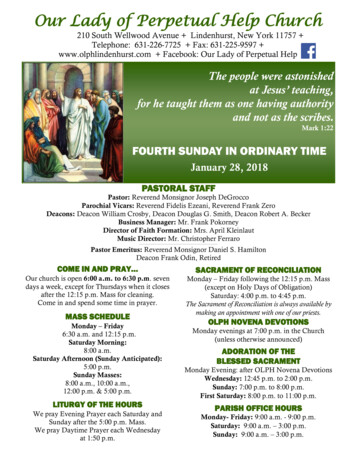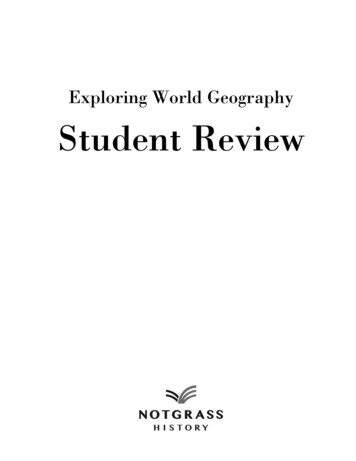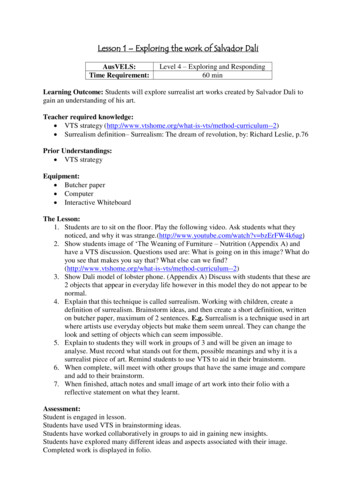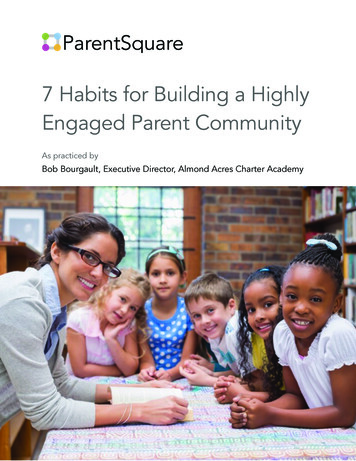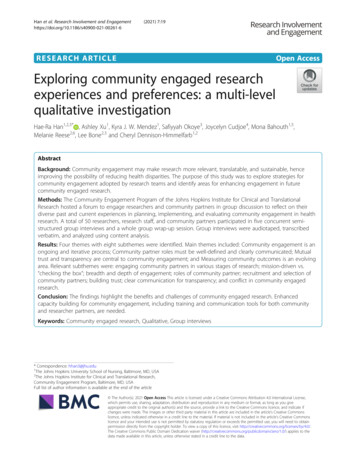
Transcription
Han et al. Research Involvement and -6(2021) 7:19RESEARCH ARTICLEOpen AccessExploring community engaged researchexperiences and preferences: a multi-levelqualitative investigationHae-Ra Han1,2,3* , Ashley Xu1, Kyra J. W. Mendez1, Safiyyah Okoye3, Joycelyn Cudjoe4, Mona Bahouth1,5,Melanie Reese2,6, Lee Bone2,3 and Cheryl Dennison-Himmelfarb1,2AbstractBackground: Community engagement may make research more relevant, translatable, and sustainable, henceimproving the possibility of reducing health disparities. The purpose of this study was to explore strategies forcommunity engagement adopted by research teams and identify areas for enhancing engagement in futurecommunity engaged research.Methods: The Community Engagement Program of the Johns Hopkins Institute for Clinical and TranslationalResearch hosted a forum to engage researchers and community partners in group discussion to reflect on theirdiverse past and current experiences in planning, implementing, and evaluating community engagement in healthresearch. A total of 50 researchers, research staff, and community partners participated in five concurrent semistructured group interviews and a whole group wrap-up session. Group interviews were audiotaped, transcribedverbatim, and analyzed using content analysis.Results: Four themes with eight subthemes were identified. Main themes included: Community engagement is anongoing and iterative process; Community partner roles must be well-defined and clearly communicated; Mutualtrust and transparency are central to community engagement; and Measuring community outcomes is an evolvingarea. Relevant subthemes were: engaging community partners in various stages of research; mission-driven vs.“checking the box”; breadth and depth of engagement; roles of community partner; recruitment and selection ofcommunity partners; building trust; clear communication for transparency; and conflict in community engagedresearch.Conclusion: The findings highlight the benefits and challenges of community engaged research. Enhancedcapacity building for community engagement, including training and communication tools for both communityand researcher partners, are needed.Keywords: Community engaged research, Qualitative, Group interviews* Correspondence: hhan3@jhu.edu1The Johns Hopkins University School of Nursing, Baltimore, MD, USA2The Johns Hopkins Institute for Clinical and Translational Research,Community Engagement Program, Baltimore, MD, USAFull list of author information is available at the end of the article The Author(s). 2021 Open Access This article is licensed under a Creative Commons Attribution 4.0 International License,which permits use, sharing, adaptation, distribution and reproduction in any medium or format, as long as you giveappropriate credit to the original author(s) and the source, provide a link to the Creative Commons licence, and indicate ifchanges were made. The images or other third party material in this article are included in the article's Creative Commonslicence, unless indicated otherwise in a credit line to the material. If material is not included in the article's Creative Commonslicence and your intended use is not permitted by statutory regulation or exceeds the permitted use, you will need to obtainpermission directly from the copyright holder. To view a copy of this licence, visit http://creativecommons.org/licenses/by/4.0/.The Creative Commons Public Domain Dedication waiver ) applies to thedata made available in this article, unless otherwise stated in a credit line to the data.
Han et al. Research Involvement and Engagement(2021) 7:19Plain ENGLISH summaryInvolving communities in the research process can makebetter the way research is planned, carried out, and used.With growing interest and support for community engagement, it is important to understand the views andinsights of people who experienced community engagedresearch. To explore the key lessons learned by community engaged research teams, we held five group interview sessions with 50 research investigators, researchstaff, and community partners. Our findings showed thatcommunity engagement is not static but a dynamic, ongoing process. Community partners felt that involvingthem earlier and in all aspects of the research processwould make for better science. Researchers were oftentorn between “checking the box” to meet community engagement requirements set by the funder of their research and engaging community partners in variousstages of research to advance the scientific mission because of time pressure. There were strong themesaround clearly defined community partner roles as wellas mutual trust and transparency, as they were considered central to successful engagement of communities inresearch. Related, participants noted that conflict between the researchers and community partners is a familiar part of the community engaged research process.Two common sources of tension were misaligned research priorities between researchers and communitypartners and lack of communication about study results.Lastly, there was little agreement between researchersabout how to measure community engaged research impact outcomes or which impact outcomes matter themost. Our findings support the need for training andcommunication tools for both community and researcher partners.IntroductionCommunity engagement is defined as the process ofmeaningfully involving communities affected by a research finding in the research process [1]. Communityengagement in research is recognized as a key process toimprove the way the research is prioritized, translated,and used in a real-life setting, and can reduce health disparities [2–5]. Community engagement can occur acrossall stages of research including identifying study topics,planning and designing the study, strengthening recruitment strategies, collecting and analyzing data, and interpreting and disseminating findings. Several United Statesfederal health agencies including the National Institutesof Health and Patient-Centered Outcomes Research Institute offer funding for community and other stakeholder engaged research, highlighting growing interestand support at the national level [6].While evidence regarding the methods of communityengagement is increasing, detailed information about thePage 2 of 9role and scope of community engagement or specific approaches to successful community engagement acrossthe full spectrum of the research cycle is still limited [7].Additionally, a systematic review of clinical trials that report patient engagement for the purposes of research revealed that an estimated less than 1% of clinical trialsengage patients in the research process and that engagement of minorities occurred in only about a quarter oftrials [8]. Growing interest in the participation and contributions of community involvement make it an opportune time to examine the key success strategies adoptedby research teams and other lessons learned, and to consider the implications for future community engagedhealth research.One of the goals of the National Institutes of HealthClinical and Translational Science Awards (CTSA) program is to promote knowledge translation by engagingpatients and communities in the research process. TheCommunity Engagement Program of the Johns HopkinsInstitute for Clinical and Translational Research—Hopkins CTSA—hosted a forum to engage researchers andcommunity partners in a dialogue to reflect on their pastand current experiences in a variety of aspects of community engaged research. This paper reports the mainthemes identified from semi-structured group discussions among diverse forum participants in relation totheir past and current experiences in planning, implementing, and evaluating community engaged research.MethodsParticipants and settingGroup discussions were chosen to identify norms of research teams in their conduct of community engaged research. The forum was publicized to researchers,research staff, and community partners within thegreater Maryland-Washington region through email invites using existing lists and word of mouth. In order toensure diversity in our forum participants, we also sentout personal, verbal, and email invitations to 100 researchers and community partners conducting community engaged research. The forum was also publicizedduring the public announcement section of meetingshosted by community advisory boards and local agencies. A total of 36 researchers and 14 community members participated in five concurrent group discussionsessions. Researcher participants consisted of researchstaff (e.g., research program coordinators, research assistants), post-doctoral fellows, and faculty investigators.Community participants included patient consultantsand prior study subjects. About 86% of forum participants indicated that they were involved in a communityor other stakeholder engaged research project at thetime of the forum, and 59% had prior exposure to community engaged research.
Han et al. Research Involvement and Engagement(2021) 7:19ProceduresA planning committee was formed to develop the goals,agenda and format of the forum. The planning committee included key faculty and staff from the HopkinsCTSA. Also included were members of the Johns Hopkins Community Research Advisory Council—a researchreview committee consisting of community residents,representatives of local community organizations, andcommunity advocates. The planning committee metover a 3-month time period for a total of 12 meetingsand developed forum goals and objectives as well as format, content, and discussion methods. The planningcommittee set the main goal of the forum to bring together investigators, patients, community members, andother stakeholders to share their experiences working together on research that addresses health and social issues that impact Greater Baltimore, Maryland. The 3-hforum began with opening by Director of Johns HopkinsInstitute for Clinical and Translational Research,followed by the keynote presentation by a director ofone of the health disparities research centers at theJohns Hopkins University. Participants were then askedto join one of five breakout groups to discuss the following topics: 1) identification and selection of communitypartners; 2) community partner roles and responsibilities; 3) approaches to promoting community engagement; 4) process and impact evaluation of engagement;and 5) scope of community engagement (see Table 1 forexample questions). The forum planning committeegrouped the participants into five breakout discussiongroups based on their topical preferences, past experiences, and their expertise that were collected duringregistration. Following the breakout sessions, forum participants reconvened and representatives from eachbreakout group briefly summarized their discussion andpresented the key themes of their respective breakoutgroup discussion.Four of the five breakout groups included both researchers and community members. The fifth group included community members only in order to maximizecomfort and sharing of relevant experiences byPage 3 of 9community members. Each breakout group included 7–11 members and had a moderator to facilitate the discussion (except for the community member-only groupwhich had two co-moderators—one community leaderand one researcher), a note taker to transcribe key discussion points for the facilitation of post breakout discussion report out, and two recording devices to recorddiscussion content. Moderators were all well-establishedresearchers with prior and/or current community engaged projects. They had experiences in working withcommunity members and had prior experiences in moderating group discussions. The moderators had specificinstructions with a semi-structured discussion guide tofollow in order to maximize the exchange of informationand facilitate productive discussion. The note takerswere all doctoral students who had previous experiencesin qualitative research. They were all briefed and trainedon the forum purpose and methods. The duration ofeach group discussion was 1 h. Forum participants provided written permission to audio record the discussionand transcribe notes. The Johns Hopkins InstitutionalReview Board considered this a quality improvementproject and waived it from a full review.AnalysisEach group discussion was audio recorded and transcribed verbatim by the original note takers. Followingtranscription, qualitative content analysis was performedby identifying common themes across group discussions.A standard theme-based content analysis approach wasused to analyze the discussion results [9]. Relevantphrases and statements from each group discussion wereidentified. Phrases and concepts expressed by more thanone participant were considered validated and were included in the analysis, with all of the validated phrasesand concepts sorted into thematic groups according tosimilarity. The transcriptions were then read multipletimes, key phrases that provided specific informationrelevant to the research questions were highlighted, andkey themes were identified and supported by directquotes.Table 1 Main topics and example questions addressed by each breakout groupGroup Main topicExample questions1Identification and selection of communitypartnersHow do you identify and engage community partners in the research process?2Community partner roles and responsibilitiesHow do you define the role of community partners in health research?3Approaches to promoting communityengagementWhat tangible skills does a researcher need to engage community partners in the researchprocess?4Process and impact evaluation ofengagementHow do you acknowledge and measure the impact of community engagement?5Scope of community engagementCommunity engaged research: What is working and what is not working—Communitypartners speak out
Han et al. Research Involvement and Engagement(2021) 7:19ResultsWe identified four themes and eight subthemes from theforum. Main themes included: Community engagementis an ongoing and iterative process; Community partnerroles must be well-defined and clearly communicated;Mutual trust and transparency are central to communityengagement; and Measuring community engagementoutcomes is an evolving area. Each theme with accompanying subthemes are detailed in the following section.Page 4 of 9same page, understand the needs of the community, anddevelop trust and rapport with the community. One researcher noted:“I will say that the iterative process can actually bebig advantage I think that’s an incentive at leastfor most of the individuals that I have worked withthat they really appreciate how their ideas havetaken shape and how their input has been utilized. Ithink that can make things take a little bit moretime but ultimately it is beneficial.” (Participant 1;Research investigator)Community engagement is an ongoing and iterativeprocessForum participants indicated that the amount of timecommunity partners were engaged and the process ofengaging community partners were different at variousstages of research. The perceived importance and desireto be involved in the designing and planning stage wasdiscussed more frequently than the desire to be involvedin the other stages. Engaging in early phases of researchwas important to identify a problem and formulate theappropriate research questions. We identified three subthemes in relation to community engagement process:Engaging community in various stages of research,mission-driven vs. checking the box, and breadth anddepth of engagement.Engaging community partners in various stages of research“We should be engaged in all stages of the researchprocess” was a universal and oft-repeated sentimentwithin the Community partner group. Community partners felt researchers should be cognizant that community engagement is an iterative process, and thatresearchers’ ability to include community members andother stakeholders in all aspects of the research processis the key to success. In particular, community partnersexpressed that involving them earlier in the researchprocess would make for better science:“I think the framework is critical. The way that theresearch question is framed is critical. And I thinkthat the community and the specific community,should be involved in developing the research question. Not too many folks would find fault with effortsto improve that disease or whatever may be, but ifit’s not framed so that it applies ” (Participant 6;Member of community research advisory council)Researchers discussed actively engaging communitypartners in research through a series of ongoing, interactive process. Having open community forums (i.e.,local forums of residents and community groups toidentify issues faced by particular communities andneighborhoods and work together to address those issues) was one method to get community partners onMission-driven versus checking the boxEngaging community partners in all stages of research,however, was challenging at times. Participants discussedthe importance of community engagement to advancethe scientific mission. Yet, researchers stated that somegrant mechanism requirements seem to have a list ofcommunity engagement requirements throughout theresearch study that may not always be productive to theproject nor respectful of community partner time. Researchers noted that they do not want to waste community partners’ time unless there is a clear need for theirfeedback building on their skillset or life experiences.Valuing participant time was highlighted as one of themost difficult but important aspects of conducting research with community partners:“I think the most challenging part of our current research is for the patients that I pushed so hard toget, for them to care about this really high level, youknow, methodologic question We don’t havemonthly meetings We try to call on them for mission driven things We are very strategic aboutwhat we ask for [community partners] to provide input on we don’t just waste their time just for thesake of checking a box.” (Participant 3; Researchinvestigator).Breadth and depth of engagementOverall, community engagement was centered aroundidentifying a research question or problem. Participantsagreed that having communities identify research questions or problems is the most effective and pragmaticway of conducting community-based research. Thisprocess would ensure community buy-in when researchers decide to plan future studies in these samecommunities. One community member remarked on thegood back and forth communication between community members and researchers present when she participated in a group of people living with high blood
Han et al. Research Involvement and Engagement(2021) 7:19pressure that consulted researchers on relevant researchquestions:“So that meant a lot to us for the fact, OK, you’re listening, and you’re actually developing somethingthat’s going to, you know, cause I think what theydid was they did something that was a consensus ofwhat all of us had said. So we were really encouraged by it, and so when it comes time to actually dothe study we want to be a part of the study, youknow.” (Participant 4; Patient).Community partner roles must be well-defined andclearly communicatedResearchers expressed the need to consider the role ofthe community partners before beginning the researchprocess—what is a community partner, the role of community partners, and the best ways to identify and recruit them. There were two subthemes directlyaddressing these questions: Roles of community partnersand recruitment and selection of community partners.Roles of community partnersOften, a bidirectional relationship with the communityhelped researchers determine the role of communitypartners. Participants noted that it is important to distinguish the role of community partners, as they are the liaisons that bring the researchers into the communitywhile also acting as advisors, decision makers, and validators. Some participants called a community partner,the “mayor of the block,” the person that people in thecommunity go to or someone who would be recognizedby the community, and could “hold their own” in discussions about the community. This person would assist intranslating what is going on in the community andmonitor checks and balances.The researchers in this discussion underscored the importance of clear communication about each communitypartner’s role to assure use of common language andclarity of roles in order to optimize the partnership andresearch. A research staff member talked about the importance of clarity in communication about the community partner roles by stating:“We can be clear I feel sometimes that there is asense of, um people because they [community partners] don’t know what’s expected of them, feeling likethey are not doing what they are supposed to bedoing or that they’re we’re not.so we want to avoidthat.” (Participant 9; Research staff).Recruitment and selection of community partnersCommunity participants discussed the various ways theyfirst became involved in research and collaborated withPage 5 of 9research teams. A common theme was engagement inresearch as a form of advocacy for a medical conditionof interest. A community partner, the parent of a childwith autism, shared her experience:“I knew about clinicaltrials.gov, discovered a trial,participated in that trial and then subsequentlyasked to share my PHI [protected health information] for further research purposes and that was sortof the first time that I felt like I was asked by the research community to share information about myson’s autism and how it affects our family and soforth.” (Participant 11; Parent of a patient).From the researcher perspective, it was important tofirst identify the type of community partner that thestudy requires and then to discuss who is the individualcommunity member. Funding announcements, dissemination and implementation strategies, and knowing theskill sets of the individual community members wereuseful for selecting community partners. Nevertheless,difficulty identifying the right people to serve as community partners was a common challenge identified by researchers. Participants acknowledged the importance ofrelying on community resources and various stakeholders to identify and recruit community partners. Forexample, working with spiritual leaders and health departments, as well as getting to know and building trustwith a community helped to identify community partners. To this end, participants noted that it would beideal to the research team to establish presence andcourtship to the community of interest and establish arelationship. Being active, involved, and partnering withcommunity-based organizations would increase exposure and, in turn, enhance community partnerengagement.“Having a conversation early on about what areyour networks and really documenting that and understanding the kinds of networks that everyonebrings to the table and how you can connect withthose kinds of individuals or groups so that you canhave those relationships built in advance so thatwhen you get to the end of the process you can talkabout your findings, you are not scrambling. You’veestablished that.” (Participant 13; Research staff).Mutual trust and transparency are central to communityengagementParticipants noted that central to conducting communityengaged research is the need to develop trust and valuethe unique contributions of the community partnerswho are invested in the project. The need to developtrust between researchers and community partners was
Han et al. Research Involvement and Engagement(2021) 7:19a universal priority for forum participants. Subthemes todiscuss trust to promote community engagement were:building trust, clear communication for transparency,and conflict in community engaged research.Building trustParticipants stressed the importance of building trustlong-term with the community and not coming to thepartnership without consideration of community partners’ agendas. Building trust among community members and other stakeholders was also noted as animportant aspect of conducting ethical and effectivehealth research:“That does make a huge difference when the community sees somebody there, not with their handsout but actually wanting to be there month in andmonth out so when you do come calling or knockingor you need support, you have the stakeholders thatrelationship built that you can go to the head, theleadership of the community and they know you andthey trust you.” (Participant 8; Member of community advisory council).Clear communication for transparencyParticipants underscored that researchers must make theresearch process as transparent as possible to community members. This included clear, honest and transparent communication with community members aboutfunding, study findings, study team commitment to thecommunity, duration of the study, and the overall goalsof the study. Some community members felt, however,there was a lack of information from researchers to participants regarding results of the study.“They very often don’t even let you know what, whythey collected it, and how it impacted the analysisand then what they’re going to do with it. We neverhear that part ” (Participant 5; Patient and member of community research advisory council).Conflict in community engaged researchResearchers acknowledged that conflict between the researchers and community partners is a familiar part ofthe community engaged research process. Two sourcesof tension discussed by community partners were misaligned research priorities between researchers and community partners and lack of communication about studyresults. Researchers and community partners noted,however, that conflict was not always reported. When itwas reported, it was not always clear how to manageconflict:Page 6 of 9“I’ve been thinking a lot about [conflict] in many different [ways], but as with muscles and anything,it is essential for growth and you need pain and destruction to move on. That’s how you know how youexercise well. When your muscles are torn and theyneed to regrow and repair. Otherwise you haven’tworked out enough. It’s the same for group engagement . So how to manage [conflict] I don’t knowbut that’s key.” (Participant 17; Researchinvestigator).Measuring community engagement impact outcomes isan evolving areaResearchers discussed a variety of community engagement outcomes they believed should be measured, suchas participant attendance at meetings or activities, community partner needs, conflicts and conflict resolution,the amount of money and funding raised by communitypartners, and community partner self-efficacy. The researchers acknowledged it is easier to measure andevaluate short-term community engaged research outcomes like impact on study design rather than impacton health or impact of community engaged research ona community. However, they noted the lack of a commonly accepted impact measurement framework toguide the measurement of community engaged researchfor its impact. There was little agreement between researchers about how to measure community engaged research impact outcomes or which impact outcomesmatter the most. Community engaged research mightlack a commonly accepted impact measurement framework because it is an emerging field or as a result of differing goals of engagement that guide the evaluation ofimpact outcomes between projects. In the discussionabout impact measurement, a researcher stated:“What if we did this on the principle of justice? Howwould you measure justice? We get back to what yousaid about the goals. The goal is to incorporate justice, and that’s really why we are doing it. Can youmeasure something like that or do you want to bedemocratic. Or how would you measure whetheryour process was democratic and just or to some extent inclusiveness? It’s very hard to measure thesetypes of things.” (Participant 20; Researchinvestigator).DiscussionResearchers and policy-makers alike increasinglyrecognize the importance of seeking diverse and inclusive perspectives in translational research. Nonetheless,limited information is available about the role and scopeof community engagement or specific approaches tocommunity engagement across the full spectrum of the
Han et al. Research Involvement and Engagement(2021) 7:19research cycle [7]. In particular, this paper offers the diverse perspectives of research investigators, staff, andcommunity partners actively involved in community engaged research. This forum discussion allowed these diverse forum participants an opportunity to share theirexperiences and perspectives about the benefits andchallenges of community engaged research. Our participants noted that community engagement is an ongoingand iterative process to which mutual trust and transparency are central and that the roles of communitypartners must be well-defined and clearly communicatedfor the engagement to be successful. These main themesare overall consistent with the key principles of engagement (i.e., reciprocal relationships, partnerships, colearning, and transparency-honesty-trust) as highlightedin the recent literature [7, 10–12].Whereas all forum participants recognized the benefitsof community engaged research, some of the subthemessuch as engaging community in various stages of research suggest the need for closer dialogue between researchers and community partners in earlier phases ofresearch. It was interesting to note that researchers feltengagement should happen less, once the researchstarted; it was important for them to not waste community partners’ time by focusing on “mission driventhings.” We did not find a similar concern about timeburden among community partners. An essential element of community engaged research is the me
engagement in research is recognized as a key process to improve the way the research is prioritized, translated, and used in a real-life setting, and can reduce health dis-parities [2-5]. Community engagement can occur across all stages of research including identifying study topics, planning and designing the study, strengthening recruit-
